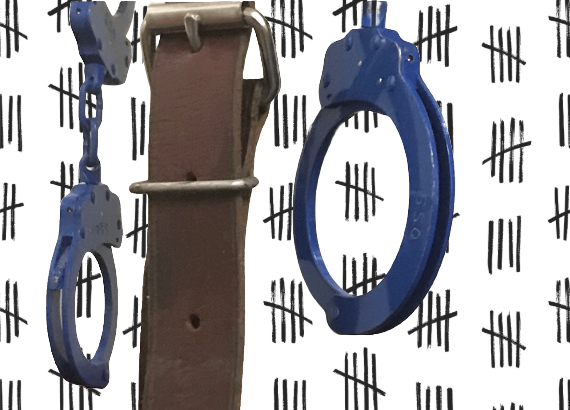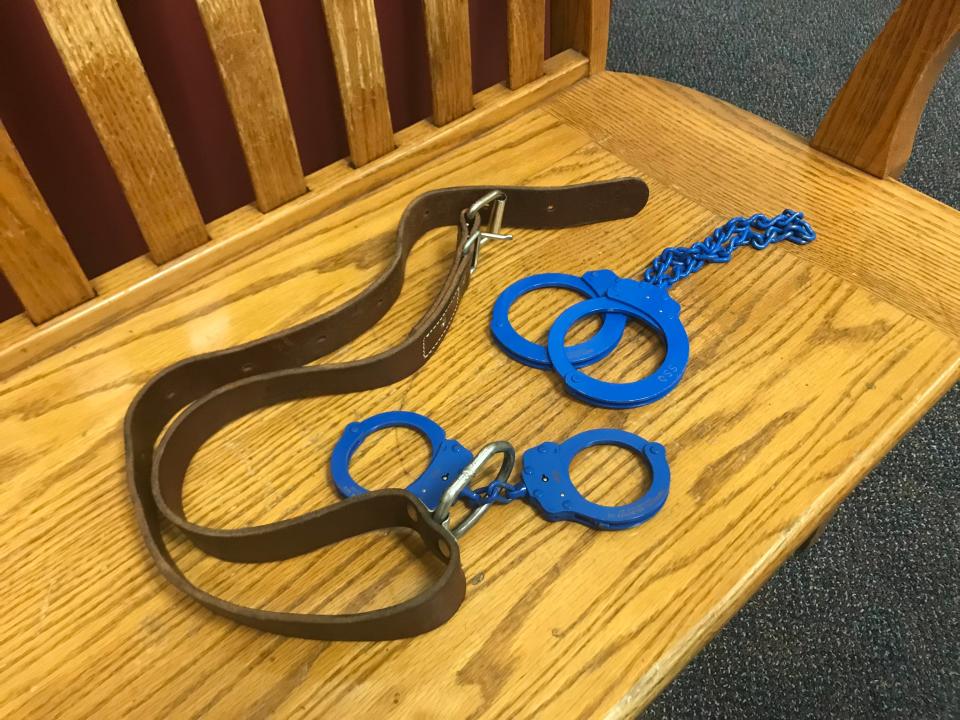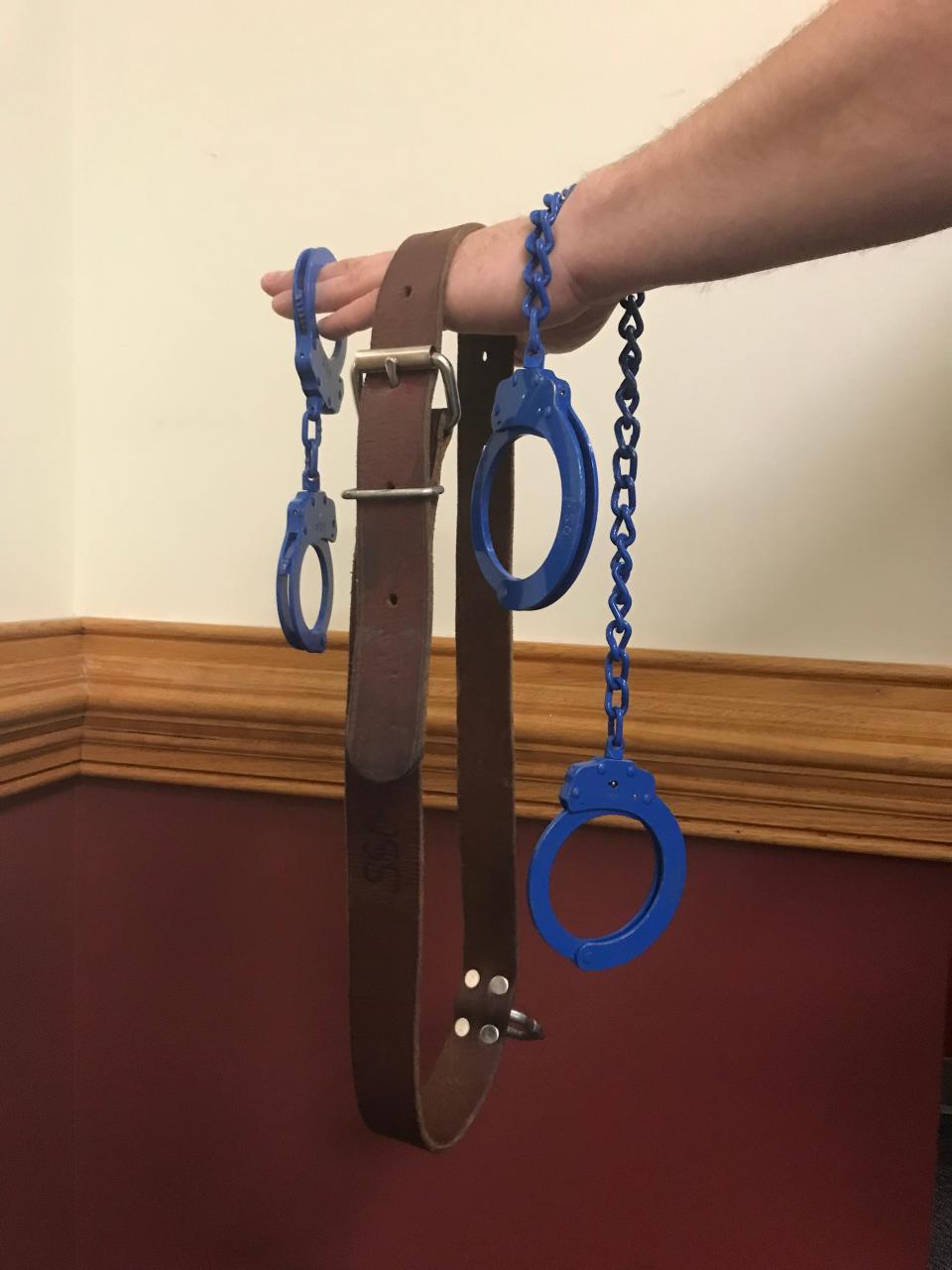Bucking national trend, Virginia courts continue indiscriminate shackling of juveniles

STAUNTON — After her son got caught stealing iPhones a few years ago and was locked up in the local juvenile detention center, M.T. recalls sitting in Augusta County Juvenile & Domestic Relations Court and watching as her boy, 14, was led in by a bailiff.
The teen, like all detained juveniles in the area who are brought into court from detention, was shackled in chains even though he was facing charges that weren't violent.
“It hurt,” said M.T., whose initials are being used to protect the identity of her son. “He held his head down. You could tell he was embarrassed, he was down on himself. It changed his whole demeanor.”
It was the teen's first brush with the law.
On a recent morning of court cases in the Augusta County General District Courthouse, where juvenile hearings take place for Staunton and the county, family members filed into a courtroom, some carrying children, others clutching important paperwork.
Nearby, a group of adults and a child were seated in a waiting room. With no cell phones to keep them occupied, some sat in a stony silence. Still others seemed bored while staring straight ahead, perhaps lost in thought, as other court attendees in the waiting room struck up small talk with strangers. Another woman in the hallway nervously bounced on the balls of her feet. Attorneys milled about conferring with clients in side rooms and hallways, out of earshot, while some local prosecutors waded through the crowd unnoticed as they headed to court. Every now and then, a bailiff's voice would come over the loudspeakers announcing the next case. "All parties for Gray report to Courtroom Two."
Through this same part of the courthouse, sometimes shackled juveniles will come slowly walking down the hallway on their way to court. Because of outdated facilities at the downtown courthouse, there's no back entrance to bring them directly to some of the courtrooms. Meredyth Eckel, an attorney with the Staunton Public Defender's Office for eight years, said she's seen this scenario play out over and over as nervous juvenile detainees shuffle into court, bound with handcuffs, leg chains and the like.
"They're always shaking, kind of jangling a little bit," Eckel said of the shackles. "I think it's humiliating."
It may be humiliating for Virginia, too, which is now in the minority of states that indiscriminately shackle juvenile detainees.

Sudden shift in many states against shacking juveniles
In 2014, only 13 states had placed legal limits on shackling juveniles, through either legislation, court rules or case law. In the years since, shackling youths as a default practice has been banned from courtrooms in state after state. According to the Gault Center, a youth rights group, 39 states plus Puerto Rico and Washington D.C., now limit or prohibit the indiscriminate shackling of children.
Virginia’s one of only 11 states in the country to continue the practice.
"Currently, the juvenile courts in Augusta County, Staunton, and Waynesboro practice indiscriminate juvenile shackling for all juveniles currently detained in Shenandoah Valley Juvenile Detention Center," Eckel wrote in a court motion filed last year in Augusta County that sought to end the practice. "Such indiscriminate shackling is against the rule of law, interferes with the juvenile’s ability to participate in his or her own defense, contradicts the purpose of the juvenile justice system, and is against juveniles’ own best interests."
The motion, one of 10 or so filed by Eckel over the years, failed just like the others.

In a 2015 policy statement by the National Center for Mental Health and Juvenile Justice, the agency said it strongly opposed the automatic or widespread shackling of juveniles appearing in court, saying the policy impacts normal development, and could be traumatizing.
"It substantially undermines the positive development of youth, compromises the basic fundamental fairness and due process guaranteed by the Constitution," the statement said, "and imposes significant additional burdens and risks upon youth with behavioral health needs who are disproportionately represented among youth in the juvenile justice system."

One size fits all: Va. courts don’t have to shackle kids. They choose to.
For some agencies, shackling starts with the leather belt.
The one and a half inch wide belt is cinched from behind, above the waist, tight enough so that a person can’t easily move it up over the ribs or down below the waist.
An open handcuff is looped through a metal ring on the front side of the belt. That cuff is closed on the detainee’s wrist, then their other wrist is cuffed as well on the loop’s other side. Just a few chain links separate the handcuffs, to further limit motion. The detainee's wrists are held almost together at about belly-button level, inches from your body. The shackles weigh just under 2½ pounds.
Chief Deputy Aaron McFarlane of the Staunton Sheriff's Office says that when applying the handcuffs, it's a general practice to slip part of an index finger in between the detainees' skin and the cuff to make sure there's enough room. "You don't want it too loose, but you don't want it too tight either," McFarlane said.
The leg irons stretch about 21 inches across (center to center), limiting mobility. If you place your feet directly in line with your shoulders and step forward so that the heel of your shoe is just beyond the toe of your stationary shoe, for most adults that’s about the length of motion allowed by the chain between the ankle cuffs.
Sgt. Aaron Rohr of the Staunton Sheriff's Office said he usually places the leg irons on defendants first before handcuffing them at the waist. To do this safely, he directs them to face a wall, lifting each leg one at a time. Or he may tell the detainee to kneel atop a bench facing forward while exposing both ankles.

Waynesboro Sheriff Christopher Johnson Jr. said it's standard policy to shackle detained juveniles to and from court. With more modern facilities in Waynesboro, juveniles are brought into court via a secure sally port. Johnson said his office did 36 juvenile transports last year, or about three per month. Augusta County generally transports about four or five juveniles per month, and Staunton averages about four.
To get a sense of the total number, think of going into your local grocery store. As you walk through, there are eight to ten people in every aisle. Feels kind of busy. Now imagine each of them shuffling with leg irons, their hands bound close to their bellies.
Checking out, you notice that every worker at the eight cash registers is also shackled.
That gives you a rough sense of what 144 shackled people might look like. That’s the estimated the number of shackled juveniles brought into our area’s courtrooms in 2023.
And these 144 are not all "violent" youths.
Eckel said that any juvenile held locally in detention — be it for fighting or stealing grandma's credit card — will be placed in restraints when they go to court. Besides the psychological impact of being shackled and led into a room full of adults, the attorney said it limits them physically.
"They have to shuffle, they can't walk normally," Eckel said. "They always leave these red marks and that's because they're really heavy. You can just tell that they're like dragging them down."
The public defender reiterated that juveniles, at least in Staunton and Augusta County, sometimes must walk through a public hallway into the courtroom, all while shackled, because there's no other way to get them in the courtroom.
"I can't imagine that's good," Eckel said. "I think they feel trapped. I think they feel like they're bad kids."
Eckel said the issue can be solved on a case-by-case basis, something she said shouldn't be too hard. Locally, the Shenandoah Valley Juvenile Center in Verona has a capacity of 58 people, according to data from the Virginia Department of Juvenile Justice. Tim Showalter, executive director of the juvenile center, said the facility averages about 25 to 30 youth per day. He said transportation decisions, including shackling, are handled by the respective police department or sheriff’s office.
In 2022, the Verona facility took in a total of 187 inmates from various jurisdictions, according to data. Eckel said it shouldn't be difficult to determine who's high-risk and who isn't. "I understand that a lot of society feels like punishment does solve problems and feels like making juveniles feel bad for doing bad things is part of the process, but I don't think making them feel humiliated in this way is part of it," she said.

The myth of unrestrained juveniles running amok in court
Kim McLaurin, associate dean for academic affairs at Suffolk University Law School in Boston, started her legal career representing juveniles in New York City. Back then, she said juveniles were mostly shackled when transported post-conviction for case reviews. The practice has since been deemed unconstitutional in New York, she said.
After moving to Massachusetts, she took a job as a law professor and ran a juvenile defender clinic. "Every kid was brought in for arraignment in shackles. It's fairly devastating to see, much less experience," McLaurin said. The shackling was done "over and over and over," she noted. "Judges would hear about the case, and then the arraignment would happen and then they'd take the shackles off like it was nothing."
The state is now listed among those that limit or prohibit the use of shackles for juveniles.
McLaurin said shackling juveniles sends the message that they're being deemed a bad person and their innocence is not believed, and that society must be protected from them. "It's almost like a self-fulfilling prophecy, that you're saying to me before I even open my mouth, before you hear anything about this case, that I'm a danger, that I'm bad, that I'm a criminal," she said.
It impacts families as well who witness the indiscriminate shackling in the court system. "The parents are also there, the caretakers, the siblings, and it's incredibly damaging for them to see their children in shackles, or their brother or sister," McLaurin said.
The dean said penal systems for adults are founded on punishment, but said juvenile facilities are supposed to be for rehabilitation. "Nothing screams you are not rehabilitatable (like) putting somebody in shackles," McLaurin said.
Changing policy in places where shackling is still a practice, like Virginia, is slow because it's the norm, according to McLaurin. "I think it's an issue of 'this is what we've always done.'"
According to the National Center for Mental Health and Juvenile Justice, shackling court-involved juveniles rose "in the late 1980s when public policy embraced a more punitive approach to juvenile crime." However, McLaurin said she's buoyed by the trend over the years that has seen many states end the practice of constantly shackling juvenile defendants, and said unsurprisingly the juvenile courts in those states have not been thrust into pandemonium by unrestrained juveniles.
"By and large there's no issue. It's not like all of a sudden kids are creating chaos in the nation's courts. It goes away and there's not a peep," she said.

Shackling is locally controlled 'per policy.' Judge won't comment.
Eckel said the routine shackling of juveniles in Virginia's courts could end, locally at least.
"This isn't something we need to change in Richmond." She said all that is needed is for the local judges and sheriffs to relent. "Every time I ask the judge to unshackle the kids they just look at the deputies and the deputies shrug, and they're like, 'Security concerns.' And the judges are like, 'Well, security concerns.' And that's it," Eckel said.
Chief Judge Correy Smith, who presides over the Staunton, Augusta County and Waynesboro juvenile courts, declined comment for this story.

Lt. Leslie Snyder, a spokesperson for the Augusta County Sheriff's Office, said juvenile defendants are "routinely cuffed and shackled per policy." The sheriff's office has an exception within the policy for juveniles under the age of 14 who aren't restrained unless suspected of a dangerous felony or if a deputy feels the child could resist, self-injure, attempt an escape, or harm the deputy.
"The ACSO puts detainees in restraints for their safety, the safety of the public and the deputies' safety," Snyder said.

Staunton Sheriff Chris Hartless said the city doesn't have a specific policy for juveniles "or adults for that matter," and said the decision is up to the officer or deputy. "Our policy here says that prisoners/detainees should be handcuffed and shackled under normal circumstances for transportation/court appearance purposes but it allows for deputy discretion in certain circumstances," Hartless said in a text. The Staunton sheriff said it comes down to safety, "especially if we have information that they are violent or a flight risk, regardless of adult or juvenile."

When shackled, 'It's all they can focus on'
Eckel said she witnessed an incident not too long ago where a deputy halted all ongoing court proceedings and insisted on changing out the shackles for her client because they were cutting off circulation and causing pain.
"Which I thought was actually a really decent thing to do. He didn't set the policy and he didn't have the power to change it, but it seemed to me like he wasn't about to tolerate any suffering or injury on his watch," Eckel said.
Amy Borror, a senior youth policy strategist at the Gault Center, said when the shackles are removed, it lets juveniles concentrate on the proceeding itself, and said it allows them to more easily interact with their attorney and get a more comprehensive understanding of the hearing. "It’s because when they’re shackled, it's all they can focus on," she said.
There's also a racial component that can't be ignored, she added. “Shackling of Black people in this country has a really horrible past, and that matters, especially if we’re talking about Black children who are walking into courtrooms where most or all of the adults in positions of power are white.”
Borror said families are impacted as well when seeing their loved ones draped in chains, and said the visceral responses can be traumatic and heartbreaking. Changing the policy, she said, improves the courtroom environment.

Reform more effective on state level, experts say
Borror said it's "remarkable" that so many states have altered their policies regarding shackling juvenile detainees since 2014. "I think it’s also telling that it’s very possible to change shackling practices without a negative impact because had a state changed their laws and bad things happened, I guarantee you we would have been hearing about it and states would have been rolling back these changes.”
She also said when local courts, including judges and bailiffs, analyze policies that are already in place, they usually conclude the practice of shackling juveniles isn't needed. “More often than not, they’re realizing they don’t need to," Borror said.
Local law enforcement doesn't seem to be prepared to do such analysis. "We do not plan on changing our policy unless the state mandates it," wrote Lt. Snyder for the Augusta County Sheriff's Office.
Staunton Sheriff Hartless wrote to The News Leader, "We would rely on the state guidance before we considered any change to our policy in conjunction we would have discussions with our judges regarding any legislative change(s)."
Although Virginia can change its shackling policy jurisdiction by jurisdiction if need be, Borror said going through the legislature would be the best route. “Our recommendation is that the reform happen at the state level," she said.
When asked why the flip-flop on juvenile shackling has been so swift in the last decade, Borror theorized it's because most people are not aware of the practice until they encounter it.
"It shocks them. People don’t think that’s what’s happening, they think of juvenile court as less criminal and more rehabilitative," she said. “It kind of shocks the conscience when people find out that children are shackled.”
Christina M. Kleiser, an assistant public defender for 18 years with the Knox County Public Defender's Community Law Office in Knoxville, Tennessee, said when the rules on shackling juvenile detainees changed in that state the only concern she remembers came from the local sheriff's department.
"They like the control," Kleiser said of sheriff's agencies in general.
The change in policy, she said, has been seamless. "I do not recall an instance where this changed anything in court. I can't remember one situation where a child responded differently because he wasn't in shackles, like tried to run off for example."
Kleiser said the body of scientific research concerning the negative aspects of shackling juveniles is growing and said law enforcement should rely on the facts. "To me," she said, "there's a lot of decisions that get made based on our gut versus based on the data and the science."
Brad Zinn is the cops, courts and breaking news reporter at The News Leader. Have a news tip? Or something that needs investigating? You can email reporter Brad Zinn (he/him) at bzinn@newsleader.com. You can also follow him on X (formerly Twitter).
This article originally appeared on Staunton News Leader: Virginia teens are shackled in court regardless of charges

